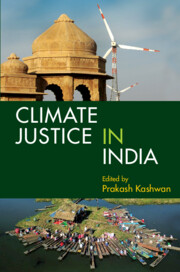Book contents
- Frontmatter
- Contents
- List of Poems and Artworks
- List of Tables
- List of Figures
- List of Abbreviations
- Preface and Acknowledgements
- 1 Introduction: Climate Justice in India
- 2 Urban Climate Justice in India
- 3 How Just and Democratic Is India’s Solar Energy Transition?: An Analysis of State Solar Policies in India
- 4 Extractive Regimes in the Coal Heartlands of India: Difficult Questions for a Just Energy Transition
- 5 Climate Justice Implications of the Relationship between Economic Inequality and Carbon Emissions in India
- 6 Climate Action Plans and Justice in India
- 7 Social Mobilizations for Climate Action and Climate Justice in India
- 8 Reimagining Climate Justice as Caste Justice
- 9 Intersectional Water Justice in India: At the Confluence of Gender, Caste, and Climate Change
- 10 Realizing Climate Justice through Agroecology and Women’s Collective Land Rights
- 11 Conclusion: Pathways to Policies and Praxis of Climate Justice in India
- About the Editor and Contributors
- About the Poets and Artists
- Index
6 - Climate Action Plans and Justice in India
Published online by Cambridge University Press: 03 November 2022
- Frontmatter
- Contents
- List of Poems and Artworks
- List of Tables
- List of Figures
- List of Abbreviations
- Preface and Acknowledgements
- 1 Introduction: Climate Justice in India
- 2 Urban Climate Justice in India
- 3 How Just and Democratic Is India’s Solar Energy Transition?: An Analysis of State Solar Policies in India
- 4 Extractive Regimes in the Coal Heartlands of India: Difficult Questions for a Just Energy Transition
- 5 Climate Justice Implications of the Relationship between Economic Inequality and Carbon Emissions in India
- 6 Climate Action Plans and Justice in India
- 7 Social Mobilizations for Climate Action and Climate Justice in India
- 8 Reimagining Climate Justice as Caste Justice
- 9 Intersectional Water Justice in India: At the Confluence of Gender, Caste, and Climate Change
- 10 Realizing Climate Justice through Agroecology and Women’s Collective Land Rights
- 11 Conclusion: Pathways to Policies and Praxis of Climate Justice in India
- About the Editor and Contributors
- About the Poets and Artists
- Index
Summary
Introduction
‘Climate change seems to be the last of the priorities of the state and central government. Despite various climate plans, we continue to privatize coal and divert forest land. How does one reconcile these decisions with the objectives of the climate action plan?’ asked a senior administrative officer in the Odisha Revenue and Disaster Management Department when questioned about the auctioning of new coal blocks and the state's climate action plan. His grim observation points to the political and economic barriers against implementing an effective climate policy that addresses climate justice in India.
In this chapter, we argue that India's climate policy fails to adequately address difficult political questions related to climate justice and rising inequality. As our analysis of state and national climate action plans show, India's engagement with questions of climate justice remains merely symbolic. This directly follows from the country's stance in international climate negotiations, during which it has shied away from undertaking rigorous domestic climate action citing high levels of poverty and a need to focus on economic growth (Kashwan and Mudaliar 2021).
Our analysis of India's national and state climate action plans offers insights into the often-unstated normative principles that guide decision-making on climate change within the country. In this study, we demonstrate how, if at all, these action plans incorporate questions of justice and equality. We argue that most of India's climate action plans demonstrate a superficial understanding of socio-economic inequalities and hence fail to adequately address the disproportionate impact of climate events on the poor and marginalized.
We begin by discussing the principles that guide climate policy internationally and domestically. We then provide a critical overview of national and state climate action plans. We then scrutinize these action plans in terms of substantive equality and climate justice criteria, namely caste, gender, poverty, and co-benefits for development. We then analyse the action plans with regard to their treatment of these substantive criteria, the limitations in their approach, and possible strategies to address these limitations.
Background
Internationally, India is known to have pioneered the approach of common but differentiated responsibilities (CBDR), which allows developing countries to prioritize poverty alleviation and economic growth over climate mitigation.
- Type
- Chapter
- Information
- Climate Justice in India , pp. 115 - 139Publisher: Cambridge University PressPrint publication year: 2024
- Creative Commons
- This content is Open Access and distributed under the terms of the Creative Commons Attribution licence CC-BY-NC 4.0 https://creativecommons.org/cclicenses/
- 1
- Cited by

